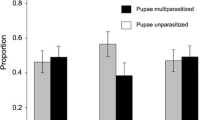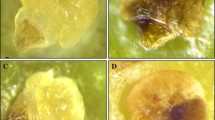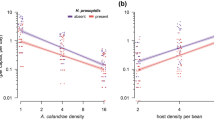Abstract
Parasitism influences many aspects of a host's behavior and physiology. Therefore, parasitism is also likely to influence the competitive ability of the host. Field populations of phytophagous insects are often a mix of parasitized and unparasitized conspecifics and the inclusion of parasitism in their competitive dynamics may alter expected outcomes. We investigated the influence of parasitism by the hymenopteran parasitoid Phanerotoma franklini Gahan on the competitive interactions among larvae of its host Acrobasis vaccinii Riley. We found that parasitized larvae were poorer competitors and required less food to complete development compared to unparasitized larvae. To examine the influence of parasitism on the competitive dynamics of this system, we constructed an individual-based model parameterized with our laboratory data. The model examined the role of resource availability and parasitism rate on larval survival. The model suggests that parasitized larvae (and, hence parasitoids) experience higher levels of mortality from competition than unparasitized larvae. Further, the model also suggests that the decreased consumption of resources by parasitized larvae results in a decline in the occurrence of competition as the parasitism rate increases. We suggest that these observations may be general to many parasitoid–host systems.





Similar content being viewed by others
References
Averill AL, Sylvia MW (1998) Cranberry Insects of the Northeast. University of Massachusetts, Amherst Extension
Bernstein C (1986) Density dependence and the stability of host-parasitoid systems. Oikos 47:176–180
Boots M (1998) Cannibalism and the stage-dependent transmission of a viral pathogen of the Indian meal moth, Plodia interpunctella. Ecol Entomol 23:118–122
Brodeur J, McNeil JN (1989) Seasonal microhabitat selection by an endoparasitoid through adaptive modification of host behavior. Science 244:226–228
Chapman JW, Willima T, Escribano A, Caballero P, Cave RD, Goulson D (1999) Age-related cannibalism and horizontal transmission of a nuclear polyhedrosis virus in larval Spodoptera frugiperda. Ecol Entomol 24:268–275
Damman H (1987) Leaf quality and enemy avoidance by the larvae of a pyralid moth. Ecology 68:88–97
Denno RF, McClure MS, Ott JR (1995) Interspecific interactions in phytophagous insects: competition reexamined and resurrected. Annu Rev Entomol 40:297–331
Feder JL (1995) The effects of parasitoids on sympatric host races of Rhagoletis pomonella. Ecology 76:801–813
Feder JL, Reynolds K, Go W, Wang EC (1995) Intra- and interspecific competition and host race formation in the apple maggot fly, Rhagoletis pomonella. Oecologia 101:416–425
Fellowes MDE, Kraaijeveld AR, Godfray HCJ (1998) Trade-off associated with selection for increased ability to resist parasitoid attack in Drosophila melanogaster. Proc R Soc Lond B 265:1553–1558
Guillot FS, Vinson SB (1972) The role of the calyx and poison gland of Cardiochiles nigriceps host-parasitoid relationship. J Insect Phys 18:1315–1321
Gupta P, Ferkovich SM (1998) Interaction of calyx fluid and venom from Microplitis croceipes on developmental disruption of the natural host, Heliocoverpa zea, and two atypical hosts, Galleria mellonella and Spodoptera exigua. J Insect Phys 44:713–719
Hairston NG, Smith FE, Slobodkin LB (1960) Community structure, population control, and competition. Am Nat 64:421–425
Hassell MP (2000) The spatial and temporal dynamics of host–parasitoid interactions. Oxford University Press, Oxford
Hawlitzky N, Boulay C (1986) Effects of the egg-larval parasite, Phanerotoma flavitestacea Fisch. (Hymentopera: braconidae) on the dry weight and chemical composition of its host Anagasta keuhniella Zell. (Lepidoptera: Pyralidae). J Insect Phys 32:269–274
Horton DR, Moore J (1993) Behavioral effects of parasites and pathogens in insect hosts. In: Beckage NE, Thompson SN, Federici BA (eds) Parasites and pathogens of insects. Academic, San Diego, Calif., pp 107–124
Hunter MD, Price PW (1992) Playing chutes and ladders: heterogeneity and the relative roles of bottom-up and top-down forces in natural communities. Ecology 73:724–732
Ives AR, Settle WH (1996) The failure of a parasitoid to persist with a superabundant host: the importance of the numerical response. Oikos 75:269–278
Jones D, Wache S (1998) Preultimate 4th/5th instar Trichoplusiani naturally injected with venom/calyx fluid from Chelonus curvimaculatus precociously metamorphose, rather than obey the metamorphic size threshold that would normally compel molting to a 5th/6th instar. J Insect Phys 44:755–765
Jones RL, Lewis WJ (1971) Physiology of the host-parasite relationship between Heliothis zea and Microplitis croceipes. J Insect Phys 17:921–927
Joyner K, Gould F (1985) Developmental consequences of cannibalism in Heliothis zea. Ann Entomol Soc Am 78:24–28
Kraaijeveld AR, Godfray HCJ (1997) Trade-off between parasitoid resistance and larval competitive ability in Drosophila melanogaster. Nature 389:278–280
Kraaijeveld AR, Godfray HCJ (1999) Geographic patterns in evolution of resistance and virulence in Drosophila and its parasitoids. Am Nat 153:S61–S74
Lafore R (2002) Object-oriented programming in C++. Sams, Indianapolis, Ind.
Maxwell CW, Morgan GT (1951) Life-history studies of the cranberry fruitworm Mineola vaccinii (Riley), in New Brunswick. Entomol Soc Ontario 82:21–25
Muesbeck CFW, Krombein KV, Townes HK (1951) Hymenoptera of America North of Mexico. USDA Agriculture Monograph, Washington DC
Park T (1948) Experimental studies of interspecies competition. I. Competition between populations of flour beetles, Tribolium confusum and Tribolium castaneum. Ecol Monogr 18:226–308
Pivnick KA (1993) Diapause initiation and pupation site selection of the braconid parasitoid Microplitis mediator: a case of manipulation of host behaviour. Can Entomol 125:825–830
Reavy D (1993) Why body size matters to caterpillars. In: Stamp NE, Casey TM (eds) Caterpillars: ecological and evolutionary constraints on foraging. Chapman and Hall, New York, pp 248–279
Reed DJ, Begon M, Thompson DJ (1996) Differential cannibalism and population dynamics in a host-parasitoid system. Oecologia 105:189–193
SAS Institute (2001) JMP statistics and graphics guide. SAS Institute, Cary, N.C.
Semlitsch RD, West CA (1988) Size-dependent cannibalism in noctuid caterpillars. Oecologia 77:286–288
Senthamizhselvan M, Muthukrishnan J (1989) Effect of parasitization by a gregarious and a solitary parasitoid on food consumption and utilization by Porthesia scintillans Walker (Lepidoptera: Lymantriidae) and Spodoptera exigua Hubner (Lepidoptera: Noctuidae). Parasitol Res 76:166–170
Sisterson MS (2001) Aspects of the ecology, behavior, and evolution of a braconid parasitoid. PhD Dissertation, University of Massachusetts, Amherst, Mass.
Sisterson MS, Gould FL (1999) The inflated calyx of Physalis angulata: a refuge from parasitism for Heliothis subflexa. Ecology 80:1071–1075
Storer NP (1999) The corn earworm, Bt transgenic corn and Bt-resistance evolution in a mixed cropping system. PhD Dissertation, North Carolina State University, Raleigh, N.C.
Tiën NSH, Boyle D, Kraaijeveld AR, Godfray HCJ (2001) Competitive ability of parasitized Drosophila larvae. Evol Ecol Res 3:747–757
Van Loon JJA, de Boer JG, Dicke M (2000) Parasitoid-plant mutualism: parasitoid attack of herbivore increases plant reproduction. Entomol Exp Appl 97:219–227
Washburn JO, Mercer DR, Anderson JR (1991) Regulatory role of parasites: impact on host population shifts with resource availability. Science 253:185-188
Wiseman BR, McMillan WW (1969) Competition and survival among the corn earworm, tobacco budworm, and the fall armyworm. J Econ Entomol 62:734–735
Yan G, Stevens L (1995) Selection by parasites on components of fitness in Tribolium beetles: the effect of intraspecific competition. Am Nat 146:795–813
Acknowledgements
We would like to thank Joe Elkinton, John Buonaccorsi, Beth Jakob, Ron Prokopy, Yves Carrière, Elizabeth Bernays, Jay Rosenheim and two anonymous reviewers at Oecologia for comments on earlier drafts of this manuscript. Marty Sylvia, Angela Pimental, Jay Cruz, and Katharine Hickey provided invaluable help with the field and laboratory work. Adam Porter provided advice on model construction. Finally, we would like to thank the Cape Cod National Seashore and the Town of Barnstable for allowing us access to the wild cranberry sites and Frank Caruso for helping obtain permission to visit these sites.
Author information
Authors and Affiliations
Corresponding author
Rights and permissions
About this article
Cite this article
Sisterson, M.S., Averill, A.L. Interactions between parasitized and unparasitized conspecifics: parasitoids modulate competitive dynamics. Oecologia 135, 362–371 (2003). https://doi.org/10.1007/s00442-003-1205-8
Received:
Accepted:
Published:
Issue Date:
DOI: https://doi.org/10.1007/s00442-003-1205-8




